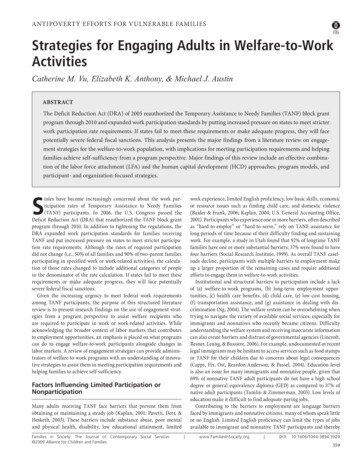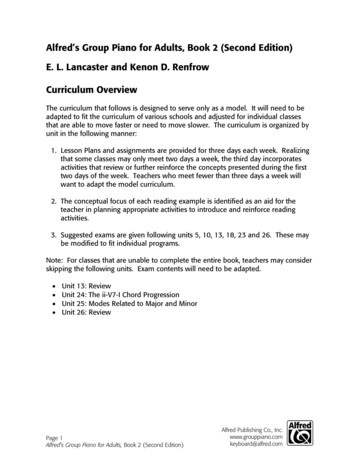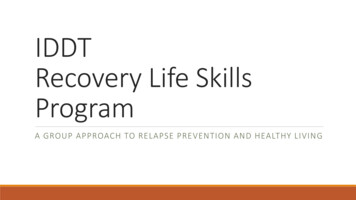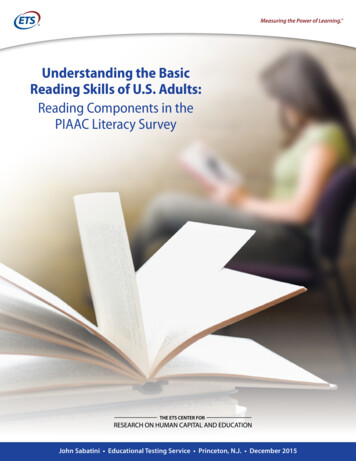
Transcription
Antipoverty Efforts for Vulnerable FamiliesStrategies for Engaging Adults in Welfare-to-WorkActivitiesCatherine M. Vu, Elizabeth K. Anthony, & Michael J. AustinABSTRACTThe Deficit Reduction Act (DRA) of 2005 reauthorized the Temporary Assistance to Needy Families (TANF) block grantprogram through 2010 and expanded work participation standards by putting increased pressure on states to meet stricterwork participation rate requirements. If states fail to meet these requirements or make adequate progress, they will facepotentially severe federal fiscal sanctions. This analysis presents the major findings from a literature review on engagement strategies for the welfare-to-work population, with implications for meeting participation requirements and helpingfamilies achieve self-sufficiency from a program perspective. Major findings of this review include an effective combination of the labor force attachment (LFA) and the human capital development (HCD) approaches, program models, andparticipant- and organization-focused strategies.States have become increasingly concerned about the work participation rates of Temporary Assistance to Needy Families(TANF) participants. In 2006, the U.S. Congress passed theDeficit Reduction Act (DRA) that reauthorized the TANF block grantprogram through 2010. In addition to tightening the regulations, theDRA expanded work participation standards for families receivingTANF and put increased pressure on states to meet stricter participation rate requirements. Although the rates of required participationdid not change (i.e., 50% of all families and 90% of two-parent familiesparticipating in specified work or work-related activities), the calculation of those rates changed to include additional categories of peoplein the denominator of the rate calculation. If states fail to meet theserequirements or make adequate progress, they will face potentiallysevere federal fiscal sanctions.Given the increasing urgency to meet federal work requirementsamong TANF participants, the purpose of this structured literaturereview is to present research findings on the use of engagement strategies from a program perspective to assist welfare recipients whoare required to participate in work or work-related activities. Whileacknowledging the broader context of labor markets that contributesto employment opportunities, an emphasis is placed on what programscan do to engage welfare-to-work participants alongside changes inlabor markets. A review of engagement strategies can provide administrators of welfare-to-work programs with an understanding of innovative strategies to assist them in meeting participation requirements andhelping families to achieve self-sufficiency.work experience, limited English proficiency, low basic skills, economicor resource issues such as finding child care, and domestic violence(Baider & Frank, 2006; Kaplan, 2004; U.S. General Accounting Office,2001). Participants who experience one or more barriers, often describedas “hard-to-employ” or “hard-to-serve,” rely on TANF assistance forlong periods of time because of their difficulty finding and sustainingwork. For example, a study in Utah found that 92% of longtime TANFfamilies have one or more substantial barriers; 37% were found to havefour barriers (Social Research Institute, 1999). As overall TANF caseloads decline, participants with multiple barriers to employment makeup a larger proportion of the remaining cases and require additionalefforts to engage them in welfare-to-work activities.Institutional and structural barriers to participation include a lackof (a) welfare-to-work programs, (b) long-term employment opportunities, (c) health care benefits, (d) child care, (e) low-cost housing,(f) transportation assistance, and (g) assistance in dealing with discrimination (Ng, 2004). The welfare system can be overwhelming whentrying to navigate the variety of available social services, especially forimmigrants and nonnatives who recently became citizens. Difficultyunderstanding the welfare system and receiving inaccurate informationcan also create barriers and distrust of governmental agencies (Lincroft,Resner, Leung, & Bussiere, 2006). For example, undocumented or recentlegal immigrants may be hesitant to access services such as food stampsor TANF for their children due to concerns about legal consequences(Capps, Fix, Ost, Reardon-Anderson, & Passel, 2004). Education levelis also an issue for many immigrants and nonnative people, given that69% of nonnative TANF adult participants do not have a high schooldegree or general equivalency diploma (GED) as compared to 37% ofnative adult participants (Tumlin & Zimmerman, 2003). Low levels ofeducation make it difficult to find adequate-paying jobs.Contributing to the barriers to employment are language barriersfaced by immigrants and nonnative citizens, many of whom speak littleor no English. Limited English proficiency can limit the types of jobsavailable to immigrant and nonnative TANF participants and therebyFactors Influencing Limited Participation orNonparticipationMany adults receiving TANF face barriers that prevent them fromobtaining or maintaining a steady job (Kaplan, 2001; Pavetti, Derr, &Hesketh, 2003). These barriers include substance abuse, poor mentaland physical health, disability, low educational attainment, limitedFamilies in Society: The Journal of Contemporary Social Services 2009 Alliance for Children and Families www.FamiliesInSociety.org DOI: 10.1606/1044-3894.3929359
Families in Society Volume 90, No. 4limit their earning potential. Huang (2002) cited a study conductedby the U.S. General Accounting Office reporting that adults speakinglimited or no English in Los Angeles and New York had a 34% higherpoverty rate than immigrant adults who speak English in those cities.Average monthly earnings for a worker with limited English proficiencywas 355, considerably less than the monthly wages of 545 that Englishspeakers made.In addition to institutional and language barriers, many TANFparticipants also have personal barriers that prevent them from obtaining secure jobs. These include depression or anxiety, stressful events,alcohol and drug use, exposure to domestic violence, and poor healthconditions (Norris & Spieglman, 2003). A survey of California TANFparticipants found that 21% to 23% of the respondents reported symptoms of depression, anxiety, or a recent stressful event within the pastyear that interfered with their ability to work, care for children, orattend school (London & Mauldon, 2006). The same survey found that11% of the respondents experienced domestic violence, and 31% had aphysical health condition preventing them from working.It is clear that significant barriers (structural/institutional, language,and personal) impact the ability of TANF participants to meet welfareto-work requirements and therefore need to be taken into considerationwhen engaging them in the process of achieving self-sufficiency. Giventhe potential decrease in caseloads as a result of implementing welfarereform, it can be assumed that those remaining on welfare encountersignificant barriers that prevent them from becoming employed andleaving assistance. Indeed, the U.S. General Accounting Office (2001)speculated that the TANF participants who could easily find and keepjobs have left welfare, leaving those with characteristics that impedeemployment to make up the remaining welfare caseload. Hamilton(2002) found that more disadvantaged TANF participants had a higherlikelihood of sanctions that lasted longer than less disadvantaged TANFparticipants. This may be due to the fact that more disadvantaged people remain on welfare longer, augmenting the amount of time duringwhich noncompliance could occur and increasing the chances of beingsanctioned. Although there is some evidence of contradictory results inthese findings (Ong & Houston, 2005), engaging all TANF participants,whether they are considered hard-to-employ or not, remains a significant concern for states.To better assist hard-to-employ TANF participants, engagementstrategies need to be evaluated for their effectiveness in moving theseparticipants from welfare to work. This analysis describes the majorfindings from the research literature on engagement strategies. Becausethere are limited studies available on this topic, this analysis primarilyrelies on two major studies that analyze the effectiveness of welfareto-work programs (Kauf, Derr, & Pavetti, 2004; U.S. Department ofHealth and Human Services, 1989–2002). Although individual welfareto-work programs have been developed and evaluated in communities(e.g., Chow, Bester, & Shinn, 2001), this analysis focuses on studies thatevaluate national, multisite programs, which contribute to the generalizability of findings.engagement strategies involving multiple sites throughout the UnitedStates found that relatively few states or counties have specific strategies to engage all or most TANF participants in work or work-relatedactivities (Kauf et al., 2004). It is clear that programs designed toengage TANF participants in federally allowable activities use differentapproaches. Different state and local strategies are reflected in nationalstudies on workforce participation. Although some of the findings arefrom the only experimental study available, others emerge from nonexperimental studies that use case study data, administrative data, andprogram evaluation data (Hamilton, 2002).The National Evaluation of Welfare-to-Work Strategies (NEWWS)analyzed the effectiveness of 11 mandatory welfare-to-work programsin seven cities: Atlanta, Georgia; Columbus, Ohio; Detroit and GrandRapids, Michigan; Oklahoma City, Oklahoma; Portland, Oregon; andRiverside, California (Hamilton, 2002). Beginning in 1989 and lasting through March 2002, this longitudinal study examined programsimplemented under the previous national welfare program, Aid toFamilies with Dependent Children (AFDC), which was replaced byTANF. Because both welfare programs maintain the goal of movingrecipients from welfare to work, the legislation change from AFDC toTANF does not affect the results of the study. As a part of the study,comparisons between different types of program approaches wereused to analyze their effectiveness in preparing TANF participants foremployment. In addition, data from the NEWWS study can be used toassess other program strategies throughout the country that seek toengage TANF participants in welfare-to-work activities.Programs can be differentiated by their approach to employment,namely, the labor force attachment (LFA) approach or the humancapital development approach (HCD). Figure 1 depicts the relationshipamong program approaches, program models, and engagement strateFIGURE 1. Relationship among program approaches, program models,and engagement strategies.PROGRAM APPROACHLFAMost Effective:LFA HCDProgram Models360Program ModelsEngagementStrategiesMajor FindingsIn light of the DRA, engagement strategies have become a major concern of administrators who are working to increase participation inwork or work-related activities. Although increasing employment anddecreasing TANF participation are the broad goals of welfare-to-workagencies, little is known about effective approaches and strategies thatcan be used by programs to yield high participation rates. A study ofHCDClient-FocusedOrganization-FocusedNote. LFA labor force attachment. HCD human capital development.
Vu, Anthony, & Austin Strategies for Engaging Adults in Welfare-to-Work Activitiesgies. The LFA approach encourages participants to obtain employmentas soon as possible, accepting jobs that may pay low wages or thatmay not be a suitable match of interests. This approach is based onthe assumption that participants can develop work habits and skillswith on-the-job learning to advance themselves. In the HCD approach,individuals are encouraged to participate in education services andskills training before they begin employment, in order to enhancetheir capacity to obtain and maintain a job. The most effective program approach incorporates elements of both the LFA and the HCDapproaches (Kauf et al., 2004).Program models reflect different approaches to engagement. Forexample, programs that use the LFA approach to employment includepaid and work experience or job-related supports into their programmodels. Programs that use the HCD approach focus on training andeducation, as well as a mentorship model to help participants learnfrom the experiences of their peers. Specific engagement strategies canbe used to recruit and retain program participants in programs thatimplement different models from either approach.Engagement StrategiesA number of participant- and organization-focused engagement strategies can be implemented in the context of different program approachesand models. To meet federal requirements, TANF participants must beengaged in one of the activities noted in Table 1 to be counted in thenumerator of the federal participation rate.In addition to the 12 federally approved activities, states can chooseto engage participants in activities that are not considered in the federalrate calculations but are allowable under state or county program rules.Although these activities vary by state, examples of these activitiesinclude physical or mental health treatment, substance abuse treatment,domestic violence counseling, and child welfare services.Kauf and colleagues (2004) found that more TANF participants areengaged in welfare-to-work activities than federal participation ratessuggest. However, these participants may not be fully meeting federalparticipation requirements. For example, using administrative datafrom El Paso County (Colorado) and the state of Utah, they found thatthe majority of TANF participants (90% and 82%, respectively) wereassigned to participate in program activities. However, a significantproportion of these participants were assigned to activities that arenot counted in the federal participation rate calculation. In a typicalmonth in El Paso County, the proportion of participants assigned toTABLE 1. Federally Countable Welfare-to-Work Activities Included inParticipation Rate CalculationThe following activities are included in the participation calculation:Unsubsidized employmentSubsidized private sector employmentSubsidized public sector employmentWork experienceOn-the-job trainingJob search and job readiness assistance for up to 6 weeks a yearCommunity service programsVocational educational training for up to 12 monthsProviding child-care services to an individual who is participating in acommunity service programThe activities below can count in the participation rate calculation onlyafter the first 20 hours:Job skills training directly related to employmentEducation directly related to employmentSatisfactory attendance at secondary school or in a course of studyleading to a GEDnon–federally allowable activities was 44%, in Utah the proportionwas 62%, and about 6% of participants were assigned to a combinationof allowable and nonfederal activities for both study sites. In El PasoCounty, 46% of the cases and in Utah, 20% of the cases were assigned toallowable-only activities.The study also found that the majority of participants who wereassigned to activities do not participate enough to meet the federalrequirements. In El Paso County, for example, individuals participated forabout 70% of the time that they were assigned (no similar data were available for Utah). These findings suggest that a significant number of casesare assigned to nonfederal activities or a combination of nonfederal andfederal activities. These cases were not included in the federal participation rate because they were either not engaged in any of the 12 approvedactivities or not involved for the minimum number of hours.Beyond administrative issues related to assignment of welfare-towork activities, the literature identifies a variety of helpful engagement strategies for individuals who are not participating in work orwork-related activities or not participating to the full extent required.Engagement strategies can be categorized as either participant-focusedstrategies (e.g., using case management to encourage participation)or organization-focused (e.g., administrative strategies designed toincrease engagement). These are listed in Table 2.Participant-Focused StrategiesStudies on welfare-to-work programs indicate that successful engagement strategies include a high degree of case management that beginswith intake (Freedman et al., 2000; Hamilton & Scrivener, 1999; Kaufet al., 2004). Initial comprehensive assessments are critical to identifyimmediate service needs, determine the capacities of participantsto work, and identify any special intensive needs (Kauf et al., 2004).By conducting initial assessments, case managers can identify anyimmediate needs that might interfere with their participation in workor work-related activities. For example, intake workers can screenparticipants by asking questions about basic needs (i.e., food, shelter,and clothing), transportation, or child care. Once this information isobtained, appropriate resources and referrals are provided to ensurethat barriers to employment are addressed.Alternatively, comprehensive assessments can be conducted after theinitial job search process. Participants who are unable to find a job aftera specified period of time are given an additional assessment to identifybarriers that may impede participants from finding employment (Hamilton & Scrivener, 1999). More thoroughly assessed participants can beassigned to other activities (e.g., counseling or short-term training) thatcan help them find jobs. By assessing participants who are unable tofind employment after engaging in initial activities, programs can focuson providing additional services specifically to those who demonstratea need for further assistance.Comprehensive assessments, whether conducted initially or after jobsearch attempts, can also be used to match participants with appropriTABLE 2. Summary of Engagement Strategies by CategoryPARTICIPANT-FOCUSED STRATEGIESORGANIZATION-FOCUSED STRATEGIESComprehensive assessmentsIndividualized service planningAccess to other servicesIdentifying potential participantsEmphasizing outreach effortsCommunicating a clear,consistent messageDefining broad and flexible activitiesTracking participationSanctioning for noncomplianceSetting performance standards361
Families in Society Volume 90, No. 4ate work activities. These assessments can use formal tools developedto determine participants’ interests, education, job skills, work history,and barriers to employment, or they can be in the form of assessmentinterviews conducted by experienced case managers. Results of theassessment are used to identify employment goals, match appropriateplacements, and connect participants with relevant resources and services they may need (child care, transportation, etc.).More in-depth assessments are needed to detect complex barriers toemployment (e.g., mental health issues, drug and alcohol addictions,domestic violence, or learning problems). Once identified, clinicaldiagnoses and treatment plans are created so that participants receiveappropriate services. Services can be provided in a variety of waysdepending on the resources and priorities of the counties and states.Kauf and colleagues (2004) found that participants can be screenedby specialists to assess for specific barriers either during orientationor case-planning interviews. Specialists then report back to the casemanager with a comprehensive evaluation. In other sites, case managers make referrals to specialists for an assessment only if they havereason to suspect that participants are at risk of complex barriers toemployment. Thorough assessments are needed for the development ofindividualized service plans for the hard-to-employ participants.Case managers play an important role in individualized case planning by helping participants develop employment plans to move themfrom welfare to work. Kauf et al. (2004) found that programs that soughtto engage all participants in work activities used three approaches tocreate employment plans to meet the needs of participants: (a) a workfocused, participant-centered approach to case management; (b) regular and frequent contact with participants; and (c) formal processes forencouraging progress toward self-sufficiency.A work-focused, participant-centered approach. This approachto case management emphasizes employment plans that build on thestrengths of the participants to meet their needs. Participant-specificplans that address barriers to work are developed by case managers whoencourage participants to set their own goals that also include the needsof their families to create effective case plans. In addition, integratedcase management has been found to be the most effective way to assistparticipants in meeting their employment needs. These services areprovided by one caseworker who has broad information about programsand access to resources. For example, a 2-year study of mandatorywelfare-to-work programs in Columbus, Ohio, found that participantsreceiving integrated case management had significantly higher ratesof participation in program activities and lower welfare payments (indollars) but had similar employment rates and earnings to participantswho received traditional case management (Scrivener, Walter, Brock, &Hamilton, 2001).Regular and frequent contact. Contact between case managers andparticipants in individualized case planning (either over the phone orin person) can motivate participants to engage in program activities.This outreach includes checking on eligibility changes, progress onemployment goals, additional needs for resources or supports, or otherissues that interfere with program activities. Case managers in four ofthe seven NEWWS sites are required to contact the participants in theirrelatively low caseloads (ranging from 40 to 80 in Wisconsin and from70 to 90 in El Paso County) at least once a month (Kauf et al., 2004).Other sites required case managers to contact participants every 90 daysor every 6 months, depending on caseloads.Monitoring of the progress. The third component of individualizedcase planning is monitoring of participants toward employment. Tomove participants toward their employment goals, several approaches362were found in different study sites (Kauf et al., 2004). In Wisconsin, forexample, an incremental approach is taken, in which case managersslowly move participants from a low amount of work requirements andhigh levels of support to higher work requirements and lower levels ofsupport. Similarly, Riverside County, California, implements a stepwiseprogram that moves participants through phases depending on theprogress of their employment plan. In Oswego County, New York, staffmeetings are convened to identify cases that are making progress andcases that need more support.Embedded in individualized case planning are formal processes forencouraging participants toward self-sufficiency. This can be done initially by assisting participants to identify their skills and strengths. Onceidentified, case managers and participants can work together to createand focus on realistic goals. To encourage participants to create clearemployment goals, case managers may take participants on tours ofwork sites, organize sessions for representatives from different fields totalk about their jobs, or create shadowing opportunities or internships toexpose participants to different types of employment available to themor that they may like (Hamilton & Scrivener, 1999). When employmentgoals are identified, case managers help participants set realistic shortterm goals that are consistent with their long-term objectives.Peer relations can also be influential in motivating participants. Bycreating an environment in which participants encourage each otherand learn from one another, participants can motivate each other tocontinue participating in programs. Welfare-to-work programs canfacilitate group activities, organize mentor programs, or create supportgroups that can increase participation and improve program outcomes(Hamilton & Scrivener, 1999). By creating formal processes to encourage progress, case managers are better able to assist participants inachieving their employment goals while building self-esteem and asense of accomplishment.In addition to providing comprehensive assessments and individualized service planning, successful programs provide participants withaccess to an array of other services that they may need during theirparticipation in work and work-related activities. According to severalstudies, child care and transportation are consistent barriers that individuals face when participating in welfare-to-work activities (Freedmanet al., 2000; Hamilton & Scrivener, 1999; Kauf et al., 2004). Child careassistance has been a highly influential factor in program participation.For example, in the NEWWS study of different welfare-to-work sites,6% of Riverside County participants reported that they did not participate in work programs because they did not have access to adequatechild care or any child care at all (Hamilton, 1995). Transportation hasalso been a limiting factor to participants who have found it difficult tocommute to program sites or work due to the different geographic locations of housing and employment (Hamilton & Scrivener, 1999; Ong &Blumenberg, 1994).To assist participants with child care, transportation, and otherneeds, counties can locate TANF agencies within one-stop centers thatinclude employment service providers, specialized service providers,and formal interagency collaborations. In Ohio, for example, Montgomery County’s Department of Job and Family Services is nationally recognized as one of the leading one-stop centers in the country where morethan 50 agencies provide employment and work assistance, educationand training programs, and other community-based services (Kauf etal., 2004). Similarly, locating welfare offices near specialized treatmentproviders (e.g., mental health clinics and substance abuse and domesticviolence programs) can be an effective way for case managers, providers, and participants to access resources and services. Although access
Vu, Anthony, & Austin Strategies for Engaging Adults in Welfare-to-Work Activitiesto resources and services can reduce the travel due to close proximity, itdoes not guarantee utilization by participants.Interagency collaboration can also improve service access as agenciesshare policy and program information related to best practices used in thedelivery of services, program efficiency, and service accessibility (Kauf etal., 2004). For example, in El Paso County the Community PartnershipGroup consists of approximately 45 agencies that meet quarterly to identify ways to improve service provision and coordination among serviceproviders. TANF agency staff who attend meetings share the informationlearned from these meetings with their case managers who, in turn, sharethe information about resources with participants.Participant-focused case management strategies focus on barriers towork, employment, and other motivational factors that can encouragefull participation in work or work-related activities to reduce barriersto employment and resources. Organization-focused strategies, whilemaintaining the same goal of work engagement, focus on mobilizingadministrative resources to engage participants.Organization-Focused StrategiesUnlike participant-focused strategies that motivate and encourageparticipation, organization-focused strategies are used within organizations to achieve broad engagement by clearly defining current andpotential “participants” and identifying the time period in which participation will be measured. In some states, all adults receiving TANFassistance are required to participate in program activities, while inother states, some people are exempt. Programs can rely on staff membersto identify mandatory participants, or they can use automated systems.In contrast, a “case finder” can be employed to periodically review thestatus of TANF participants and contact them to schedule orientations toparticipate in mandatory programs (Hamilton et al., 1997). Although thisstrategy is time-consuming and costly, it compensates for the shortcomings of an automated tracking system.Active outreach efforts can ensure that participants who need toparticipate in work or work-related programs are informed about program expectations and the benefits of participation. Programs using avariety of outreach methods can have higher success rates in engagingparticipants. Although communicating with participants in person andthrough the mail has been effective in recruiting participants, moreproactive measures can be taken in the form of letters, home visits, andrepeated follow-up contacts to encourage participants to sign up for orientation, as reflected in the high rate of participation in Grand Rapids(65%) and Riverside (63%; Hamilton & Scrivener, 1999).Developing outreach materials in multiple languages that are short,direct, visually engaging, and easily understood by people with a rangeof educational backgrounds can also help reach out to participantswho are not fully participating. Keeping the language simple and themessages concise can increase the chance that participants will readthe information and understand it. This in turn will make them moreinclined to follow through. Hamilton and Scrivener (1999) suggestedthat outreach materials should have sentences of no more than 10words, avoid words with more than three syllables, use an active voice,and keep away from acronyms and complicated welfare terminology.Communicating a clear and consistent message about the mission orpurpose of welfare-to-work programs can help
ment strategies for the welfare-to-work population, with implications for meeting participation requirements and helping families achieve self-sufficiency from a program perspective. major findings of this review include an effective combina-tion of the labor force attachment (LFA) and th










